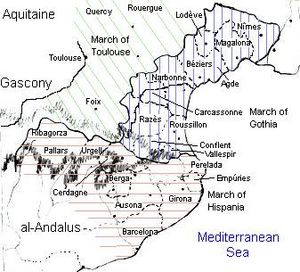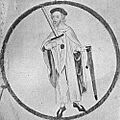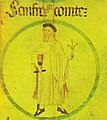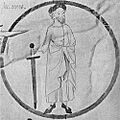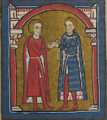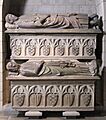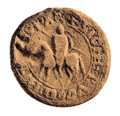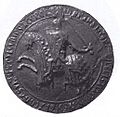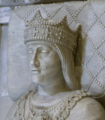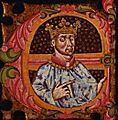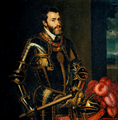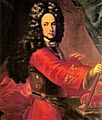Catalan counties facts for kids
The Catalan Counties were like small, independent kingdoms in the eastern Pyrenees mountains. They were created a long, long time ago by the Franks, a powerful group of people from what is now France. These counties were a buffer zone, meaning they were a protective area between the Christian Franks and the Moors (Muslims) who lived in the south.
These counties eventually grew into what we know today as Catalonia.
In 778, a famous Frankish leader named Charlemagne led an army into Hispania (what is now Spain and Portugal). His goal was to create a safe zone, called the Hispanic Marches, to protect his kingdom from the Moors. This area, which later became Catalonia, was already a bit of a "no man's land" after the Visigoths were defeated and the Muslims arrived in 714. Charlemagne's son, Louis the Pious, was made king of Aquitaine and was tasked with securing this southern border and expanding into Muslim lands.
At first, these counties were ruled by counts who were chosen by the Frankish emperor. They were like military leaders. But over time, especially with strong leaders like Wilfred the Hairy, the counts became more powerful. The Frankish kings became weaker, and the counts started passing their titles down to their children. By 987, under Borrell II, the counts became almost completely independent. They even started calling themselves "counts by the grace of God," showing they believed their power came from God, not the emperor.
Many of these smaller counties eventually joined with the most powerful one, the County of Barcelona. A Count of Barcelona, Ramon Berenguer IV, married Princess Petronilla of Aragon in 1150. This marriage was super important because it united the County of Barcelona with the Kingdom of Aragon. Their son, Alfonso II of Aragon, became the first king of the Crown of Aragon, ruling over both Catalans and Aragonese people.
Contents
How the Counties Were Created
The Franks began taking back land from the Moors in 785. That year, Rostany became the first Count of Girona. Other areas like Besalú and Empúries were originally part of Girona. In 801, young Louis the Pious achieved a great victory by capturing Barcelona, a very important city on the coast.
Around 798, Urgell and Cerdanya were also conquered and became counties, with Borrell of Ausona as their count. He helped conquer Osona in 799 and Barcelona in 801, and was rewarded by becoming Count of Osona. In 801, the largest county, County of Barcelona, was established under Bera. When Count Odilo of Girona died in 812, Girona also came under Bera's control.
After Borrell died in 820, Osona went to Rampon, and Urgell and Cerdanya went to Aznar Galíndez. Bera also lost his titles in 820, and Barcelona and Girona went to Rampon.
Empúries became a separate county around 813 and was later joined with Roussillon in 817. Besalú became a separate county in 878, with the agreement that it would pass to the family of Wilfred the Hairy after the current count died.
Barcelona quickly became the most important county, especially during the rule of Wilfred the Hairy in the late 800s. At this time, the power of the Frankish kings was fading, and the Catalan counties became almost independent. By the early 1000s, many Catalan counts refused to obey the new French kings. Over the next century, most of the Catalan counties came under the control of the Counts of Barcelona. This led to the creation of the Crown of Aragon when Ramon Berenguer IV married the princess of Aragon.
Catalan Counties and Viscounties
Here are some of the main counties and viscounties that existed:
| Catalan Counties | Catalan Viscounties |
|---|---|
|
|
Important Rulers and Dynasties
The history of the Catalan Counties is largely shaped by the families who ruled them.
The Bellonid Dynasty (Counts of Barcelona)
The Bellonid family was very important, especially the Counts of Barcelona. They gradually gained control over many other counties.
- Wilfred the Hairy (ruled 878-897): He is considered a founding figure of Catalonia. He was the first count to pass his titles directly to his children, making the counties hereditary. He expanded his territory and became very powerful, almost independent from the Frankish kings.
- Borrell II (ruled 947-992): During his time, the Frankish king didn't help Barcelona against a Muslim attack. Because of this, Borrell II stopped recognizing the Frankish king's authority, making the County of Barcelona truly independent.
- Ramon Berenguer I (ruled 1035-1076): Known as "the Old," he greatly expanded the county's power and influence. He bought several other counties and established laws that helped organize the growing territory.
- Ramon Berenguer III (ruled 1082-1131): Called "the Great," he continued to expand the county, even gaining control of Provence (in modern-day France) through marriage. He also led military campaigns against the Moors.
- Ramon Berenguer IV (ruled 1131-1162): His marriage to Petronilla of Aragon was a turning point. It created the Crown of Aragon, a powerful new kingdom that included Catalonia.
The House of Pallars
The County of Pallars was another important region in the Pyrenees. It was often divided into Upper (Sobirà) and Lower (Jussà) Pallars.
- Raymond I (ruled 872-920): He was the first hereditary count of Pallars and Ribagorça, establishing his family's rule in the region.
- Over time, the Pallars counties faced challenges from neighboring kingdoms and internal family divisions. Lower Pallars was eventually absorbed by the County of Barcelona in 1192. Upper Pallars continued to be ruled by different families until it was also joined with Aragon in 1487.
Later Dynasties (Trastámara, Habsburg, Bourbon)
After the Bellonid dynasty, the County of Barcelona (and the Crown of Aragon) was ruled by other powerful European families.
- House of Trastámara (1412-1516): After the last Bellonid king died without children, the Crown of Aragon (including Barcelona) passed to the Trastámara family. This led to some conflicts, including the Catalan Civil War (1462-1472), where Catalans fought against their king, John II of Aragon. During this war, the Catalans even offered the title of Count of Barcelona to other foreign rulers for a short time.
- House of Habsburg (1516-1700): This powerful family ruled a vast empire, including Spain and its territories. Kings like Charles I and Philip I were also Counts of Barcelona. However, tensions grew between the kings and the Catalan authorities, leading to the Reapers' War (1640-1652), where Catalonia briefly sided with France.
- House of Bourbon (1700-present, with interruptions): The death of the last Habsburg king led to the War of the Spanish Succession (1701-1714). Catalonia supported a different claimant, but the Bourbon candidate, Philip V, won. After the war, Philip V abolished many of Catalonia's traditional laws and institutions with the Nueva Planta decrees. This meant the title of Count of Barcelona lost its real political power and became more of a historical title.
In more recent times, during the Napoleonic Wars (1808-1813), Napoleon briefly annexed Catalonia to the French Empire. After that, the Bourbon dynasty returned to power in Spain. The title of "Count of Barcelona" is still used by the Spanish royal family today, though it no longer represents a separate political entity.
Images for kids
See also
 In Spanish: Condados catalanes para niños
In Spanish: Condados catalanes para niños


